Middle East oil producers are looking downstream for their future.
The region’s national oil companies have embarked on a new phase of investment in refining and petrochemicals projects both at home and overseas. Their goals are to secure markets for the region’s crude grades and ample supply of products to meet rising domestic demand.
With the commissioning of several new refineries, the Middle East is set to become not only the largest crude oil exporter but also the largest oil product exporter in the world. Refineries in the region consume around a quarter of the crude oil produced domestically, and the Paris-based International Energy Agency predicts the share rises to more than one-third by 2040 as more than 4 million barrels per day of net refining capacity is added.
Earlier this year Saudi Arabia’s state-owned giant said it had agreed to develop a $44 billion mega-refinery on India’s west coast capable of processing 1.2 million bpd of crude. This ranks it “among the largest world refining and petrochemical projects”, Saudi Aramco noted.
And the downstream deals look set to continue, with Saudi Arabia looking to consolidate at home as well as abroad. Aramco recently said it is looking to take a stake in petrochemical maker Saudi Basic Industries Corp (Sabic). Aramco aims to up its refining capacity to between 8 million and 10 million bpd, from around 5 million bpd, and double its petrochemicals output by 2030.
While Opec’s biggest producer is the most active in the area, Abu Dhabi National Oil Company (Adnoc) aims to invest $45bn over the next five years to create the world’s single largest integrated refining and petrochemicals destination at Ruwais with a capacity of 1.5 million bpd. This will help the UAE gain market share dominance, especially in Asia-Pacific, with India and China the biggest consumers of Middle East crude and its products.
Adnoc has also signed a strategic cooperation agreement with China National Petroleum Corp, which again is likely to be win-win for both producer and consumer, securing supply and developing downstream opportunities as part of the plan.
_______________
Read more:
Energy reform is a price worth paying
Middle East bunkers provide safe port in IMO 2020 storm
_______________
Aramco is leading the way with its strategic reach as it mulls expanding its 600,000 bpd Texan refinery which is the largest in the US by capacity. The Saudi company part owns US subsidiary Motiva, which wants to take advantage of natural gas from US shale fields to develop plastics. With the Middle East facing competition from cheap US shale gas, Aramco’s longstanding presence in the US is a crucial advantage.
The region’s refineries are also increasingly more sophisticated. New facilities are designed to minimise fuel oil output and maximise diesel and petrol production. The International Maritime Organisation’s new sulphur regulations for the shipping industry in 2020 could result in a glut of excess fuel oil. S&P Global Platts Analytics estimates the cost of the IMO sulfur cap at $1 trillion over the next five years as refiners and shippers scramble to meet the 0.5 per cent sulphur cap on fuel that is set to transform global oil markets.
The downstream diversification will enable the region to meet other significant demand trends and be nimble enough to adapt to ever changing conditions. Take plastics for instance, with global demand for polyethylene having almost doubled in the past couple of decades and this could continue even with the environmental pressures to recycle.
“As long as GDP growth remains strong demand for petrochemicals will remain strong,” said S&P Global Platts Analytics’ Jennifer Van Dinter, noting the infrastructure isn’t there to turn the tide against plastics just yet. The Middle East plans to build out new petrochemical capacity in the early 2020s and take advantage of this key source of demand growth.
As oil majors have witnessed, having a foot in both the upstream and downstream camps helps guard against volatility in oil prices. While oil producers are more content with prices above $70 a barrel again, it was those producers that had greater diversification in refining that tended to be better placed after prices hit a nadir of below $30 in early 2016.
With radically changing oil demand trends, the Middle East petroleum sector is adapting fast.
Paul Hickin is associate director for oil at S&P Global Platts.






